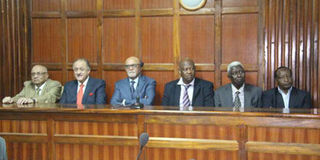Warning signs on graft purge from five decades

Anglo Leasing suspects, from left, Chamanlal Kamani, Deepak Kamani, Rashmi Kamani, David Onyonka, Joseph Magari and Dave Mwangi at the Milimani Law Courts on march 29, 2016 during the hearing of their case. PHOTO | FILE | NATION MEDIA GROUP
What you need to know:
- By the time the Makau Task Force finished its report, Narc’s anti-corruption drive against land grabbing had been politicised and framed as anti-Kalenjin witch hunt,” said Mr Murungi.
After Mr Kibaki and Mr Raila fell out over a pre-election (2002) Memorandum of Understanding (MOU), the anti-corruption drive fizzled out.
It is telling that the renewed war on mega corruption has only received a new impetus after President Kenyatta and Mr Odinga closed ranks with the March 9 handshake.
Way back in 1972, then Finance Minister Mwai Kibaki, invited an International Labour Organisation (ILO) team of experts to help study Kenya’s unemployment and income inequalities and make recommendations on how to confront the rising evidence of skewed distribution of economic development.
In its report, the ILO team included a sobering warning: “We realise action may be difficult - politically, administratively, financially and psychologically.
It may represent a break with familiar traditions and offend or hurt sectional interests. But when the cost of action is weighed, we plead that the cost of inactions also be considered... the cost of dealing with problems may be much higher when they pass the threshold of what is considered tolerable...”
This warning would return to haunt Mr Kibaki decades later as President, when he attempted to tackle a pervasive corruption menace that, as the ILO team had warned, seemed to have passed the tolerable threshold.
According to Kibaki’s cabinet minister, Mr Kiraitu Murungi, who barely 10 years ago was running for cover from Uhuru Kenyatta’s high profile drive against Anglo Leasing infamy as chairman of the Public Accounts Committee (PAC), corruption fights back viciously, unless the President has the public solidly behind him.
TRAGIC COSTS
According to Mr Murungi, one of the most tragic costs corruption has inflicted on Kenya is that it stalled, diverted and sunk the Narc administration’s (2003-2007) attempt at transitional justice through the Truth, Justice and Reconciliation Commission (TJRC).
“We set up the TJRC Task Force headed by Prof Makau Mutua, and which recommended a TJRC process to resolve historical injustices.
By the time the Makau Task Force finished its report, Narc’s anti-corruption drive against land grabbing had been politicised and framed as anti-Kalenjin witch-hunt,” said Mr Murungi.
Soon, former Kanu power elite from Kalenjin land and former Kanu comrades who had joined Narc through the Liberal Democratic Party (LDP) closed ranks in Parliament, he added.
“Mr Kibaki could not open a TJRC battlefront and fight insurgency in Parliament at the same time” he said at the time, explaining how TRJC's agenda fell off Kibaki’s list of priorities.
From then on, survival assumed higher priority than implementation of pledges Narc made on the campaign trial.
ANTI-CORRUPTION
Mr Murungi was also Kibaki’s anti-corruption tzar, as Minister for Justice and Constitutional Affairs, and cabinet anti-corruption committee chair. He exuded confidence in his robust launch of a series of anti-corruption initiatives, complete with the Public Officer Ethics Act (2003) .
Barely two years into the first term, all senior members of Kibaki’s kitchen cabinet, from his personal assistant of many years, Mr Alfred Gitonga, Internal Security Minister Chris Murungaru, Finance Minister David Mwiraria, Education Minister George Saitoti, Finance Permanent Secretary Joseph Magari, Home Affairs Permanent Secretary Sylvester Mwaliko, his Internal Security counterpart Dave Mwangi and then director of CID Joseph Kamau had all succumbed to graft investigations.
A stark difference between retired President Kibaki and President Kenyatta is that the former did not seem to fumble and fuss about matters once public opinion focussed attention at some aficionado's misconduct.
For instance, Mr Murungi and former Finance Minister Amos Kimunya would hear on live TV Mr Kibaki announcing he had “accepted” their resignation to facilitate investigations, while they were still pleading their innocence at another part of town.
TOP TECHNOCRATS
In his 2012 biography, An Odyssey in Kenyan Politics, Mr Murungi, now the Meru Governor, recounts Mr Kibaki’s statement of resolve on the corruption agenda in his speech during the official opening of Parliament in 2003: “Corruption, they say, begins at the top. Now the fight against corruption in Kenya will start at the top.”
Soon, nearly half his Cabinet, closest political allies and top technocrats would be stewing in the corruption soup.
Mr Murungi’s biography also recounts how former Prime Minister Raila Odinga, then Public Works Minister, defended Kibaki’s anti-corruption drive against accusations it was a witch hunt targeting Luo civil servants following the axing of former Deputy Public Prosecutor, Mr Bernard Chunga.
After Mr Kibaki and Mr Raila fell out over a pre-election (2002) Memorandum of Understanding (MOU), the anti-corruption drive fizzled out.
POLITICAL BACKLASH
It is telling that the renewed war on mega corruption has only received a new impetus after President Kenyatta and Mr Odinga closed ranks with the March 9 handshake.
President Kenyatta’s revamped anti-corruption drive has assumed political dimensions triggering familiar political backlash, with senior members of the Jubilee Party claiming witch hunt against their communities and political comrades.
The President’s resolve and spine to deal a lasting dent on the entrenched culture of looting public coffers by political elite and their civil service cohorts, remains to be seen. How he deals with political comrades caught with their fingers in the cookie jar, will be telling .



